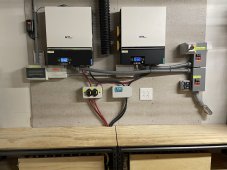Yeah, I'm gonna bite the bullet. We're doing the second array of panels next week which will take me to 14kw but not really since these LV6548 inverters clip my input at around 17a. I end up getting a little under 6kw from the current 16 panels so that should go to 12kw with double the panels. I want to put at least one or two of my new Mitsubishi heat pumps on solar and that's going to work way better if I double the battery storage as well. I've gone back and forth on DIY batteries vs another rack of EG4. I'm probably going with the EG4 again. I'm only 3 hours away so I can drive up to Sulpher Springs and pick them up and check out the Signature Solar facility. I'll try to take some pictures if they don't mind. Maybe I can catch
@SignatureSolarJames doing one of his experiments or videos!

Maybe next phase I'll do some DIY batteries. But this hemorrhaging of money needs to slow down for a few months. If this size battery bank works out well I might look at upgrading to different inverters and put these MPPs on the shop or something. But when I look at all the alternatives there's always something I don't like, which is how I ended up with these. I'd like to do something like the EG4 8KW but it looks like it only supports 3kw of PV per input x 4 inputs. I'd have to reconfigure all the panels which would be a pain. I figure this tech is changing so fast there will be something wondermous out there in another year or two.




